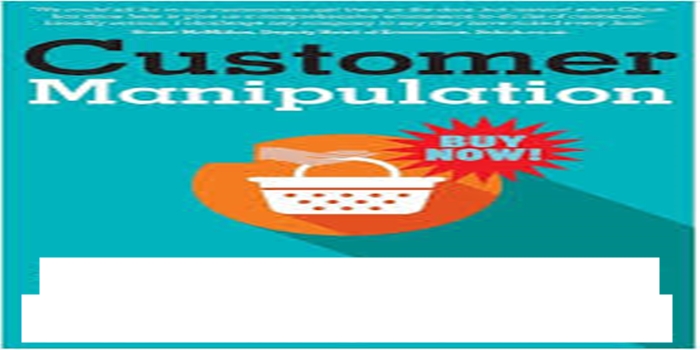In this article, we explained the meaning of consumer manipulation in marketing, the characteristics, the examples and the consequences.
Definition
Consumer manipulation in marketing refers to strategies used to influence consumers purchasing decisions through convincing methods that can be deceptive or unfair. It involves using hidden tactics to undermine consumer autonomy, often with limited transparency and poor information quality, making consumers feel deceived.
Characteristics of Consumer Manipulation:
Hidden Tactics:
These tactics are not overtly clear or transparent, and they can be difficult for consumers to identify or understand.
Limited Transparency:
Companies may not provide all the necessary information about their products or services, making it difficult for consumers to make informed choices.
Poor Information Quality:
The information provided may be misleading, deceptive, or incomplete, creating confusion or misrepresenting the value of a product or service.
Perceived Restriction of Autonomy:
Consumers may feel their freedom of choice is limited or controlled by manipulative tactics, leading to a sense of being manipulated or tricked.
Feeling of Being Tricked:
Consumers may feel that they have been deceived or mislead, even if they don’t explicitly know how.
Here are Some Examples of Consumer Manipulation:
- Dark Patterns: These are website or app features designed to subtly trick consumers into making decisions they wouldn’t otherwise make. Examples include:
Hidden costs or fees: Adding unexpected charges to a purchase without clear notification.
Scarcity tactics: Creating a sense of urgency by saying “limited quantities” or “only a few left” to pressure immediate purchase.
Confusing or misleading navigation: Making it difficult to find information, cancel subscriptions, or navigate away from a purchase.
- Greenwashing: Misrepresenting a product or service as environmentally friendly to appeal to eco-conscious consumers when it’s not genuinely sustainable.
- Price Discrimination: Offering different prices to different customers based on their perceived willingness to pay, often without transparency.
- Fear Tactics: Using fear, doubt, or threats to influence consumer behavior, such as making it difficult to cancel a subscription or by implying that a product is essential for one’s safety or well-being.
- Bait-and-Switch: Advertising a product at a low price but then pressuring the consumer to buy a more expensive alternative.
- Inflated Anchor Prices: Using inflated prices as a starting point for sales, making the discounted price seem more appealing than it actually is.
- Exaggerated Claims: Using overly optimistic or misleading claims about a product’s benefits without providing sufficient evidence.
- Social Proof: Using testimonials or reviews that are not genuine or representative to create a false sense of trust.
- Poorly Disclosed Paid Endorsements: Failing to clearly disclose when influencers or social media users are being paid to promote a product.
- False or Misleading Information: Presenting inaccurate data or misleading information to influence purchase decisions.
- Targeting Vulnerable Audiences: Exploiting the vulnerabilities of certain groups, such as those with limited financial literacy or those who are easily persuaded, to make them buy things they don’t need or cannot afford.
- Information Manipulation: Omission or biased presentation of data to influence consumer decisions, such as exaggerating benefits while omitting drawbacks or using false statistics.
Negative Consequences of Consumer Manipulation:
Erosion of Trust:
When consumers feel manipulated, they are less likely to trust the company or the brand. This erosion of trust can have long-lasting effects on customer relationships.
Reduced Satisfaction and Loyalty:
Feeling tricked or manipulated can lead to dissatisfaction with the product or service, as well as a decreased likelihood of future purchases or recommendations.
Negative Brand Attitude:
Manipulation can negatively impact consumers’ overall perception of the brand, making them less likely to view it positively.
Reduced Purchase Intentions:
Consumers who feel manipulated may be less inclined to make purchases, even if the product or service meets their needs.
Decreased Sharing Intentions:
Consumers who have experienced manipulation may be less likely to share positive experiences or recommendations about the brand with others, potentially damaging its reputation.
Moral and Ethical Concerns:
Manipulative tactics can raise ethical concerns about the practices of companies and their impact on consumers.
Potential for Boomerang Effects:
In some cases, manipulative tactics can backfire, leading to negative publicity and a decline in sales.
Increased Risk of Fraud and Deceptive Practices:
The use of manipulation can pave the way for more deceptive practices, further damaging consumer trust and market integrity.
Impact on Innovation and Long-Term Growth:
By focusing on manipulation tactics, companies may neglect building genuine value and fostering long-term customer relationships, potentially hindering their growth and innovation.
Conclusion
Consumer manipulation in marketing is the deceiving or unprincipled tactics used by marketers to influence consumers to buy products or services, often by playing on emotions, biases, or weaknesses. These tactics can create a desire to purchase that doesn’t necessarily reflect genuine needs or desires.
READ: Micro-Moments in Consumer Behavior


